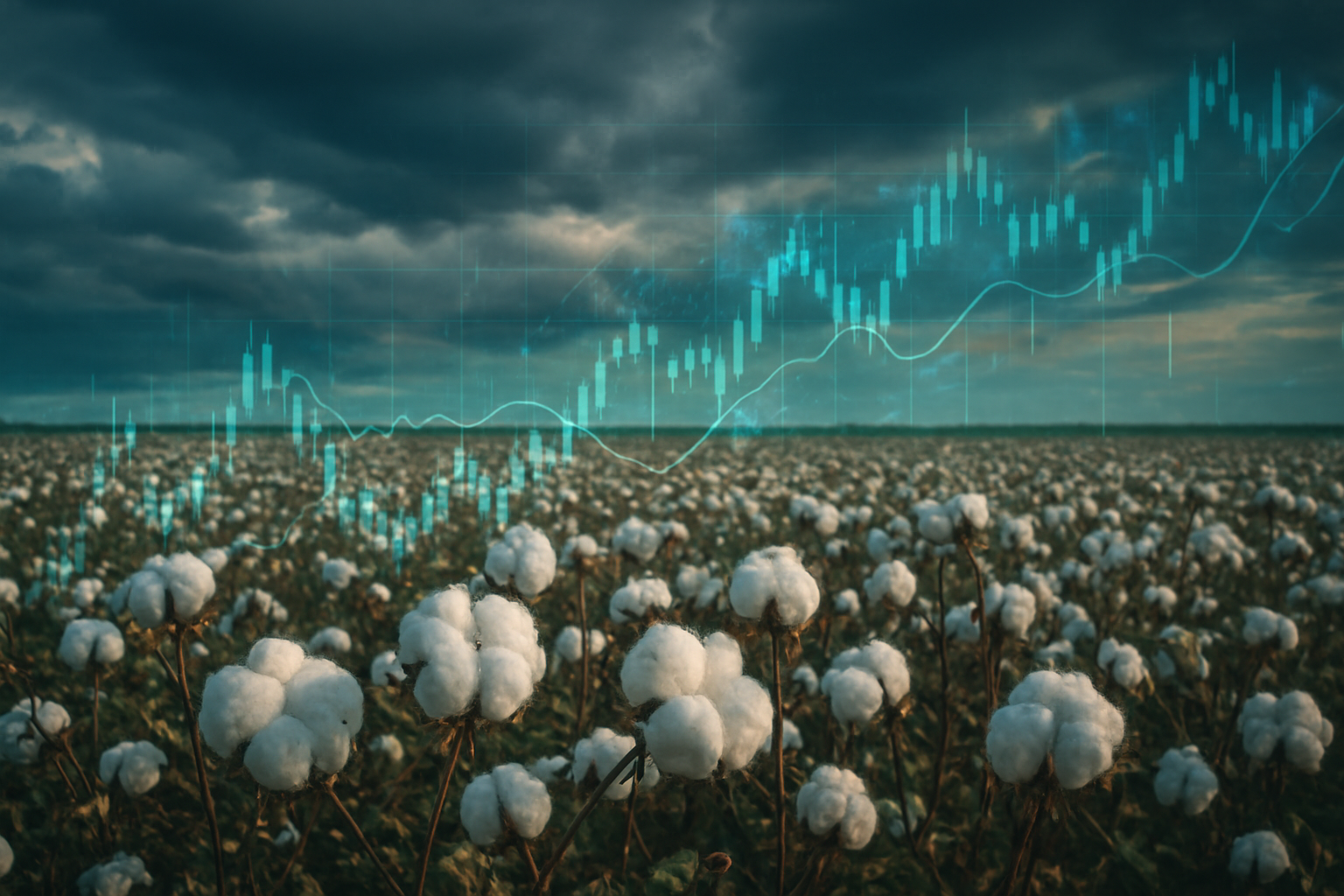
The global cotton futures market experienced a period of significant volatility in late October 2025, culminating in notable, albeit fluctuating, gains across various contracts. While a recent Friday session (October 31, 2025) saw cotton futures rise by 12 to 43 points, with the December 2025 contract gaining 43 points to settle at 65.55 cents per pound, this upward movement occurred within a broader context of uncertainty and underlying bearish pressures. The market's immediate implications point to a delicate balance between supportive external factors, such as rising crude oil prices and renewed US-China trade optimism, and persistent challenges, including a US government shutdown delaying crucial agricultural data and ongoing supply-demand imbalances.
This complex interplay has created a challenging environment for stakeholders across the supply chain, from growers to textile manufacturers and apparel brands. While the recent gains offered a glimmer of hope, the market remains characterized by a "tug-of-war" that could dictate future price trajectories and necessitate strategic adaptations for businesses navigating these choppy waters.
Unpacking the Market's Recent Movements
The late October 2025 period for cotton futures was less a singular surge and more a series of dynamic price movements, reflecting a market grappling with numerous influences. While the close of October 31 saw an increase, the preceding days and weeks were marked by considerable fluctuations. For instance, cotton futures had rallied on October 30, with December 2025 contracts up 96 points, only to see a dip on October 31 across most front months before recovering slightly to close higher than the previous day. Despite these daily upticks, cotton prices on October 31, 2025, were still down 0.12% over the past month and a significant 6.70% compared to the same time last year, highlighting a persistent bearish undertone.
Several key factors contributed to this intricate market dynamic:
- Supply/Demand Dynamics: Global cotton production for the 2025/26 marketing year is projected to decline, with some estimates pointing to a 3% decrease to 116.7 million bales, largely due to reduced output in China, India, Turkey, and Australia. India's cotton production for 2024/25 is expected to hit its lowest in over 15 years, primarily due to adverse weather and pest infestations. Conversely, Brazil anticipates an abundant 2025/26 harvest, and the U.S. expects an 18% increase in exports despite an 8% production decline. On the demand side, global consumption is expected to rise by 3% to 119 million bales in 2025/26, driven by economic recovery and strong demand from textile hubs, particularly China. However, high global stock levels continue to exert pressure on prices.
- Geopolitical Events: Optimism surrounding a potential US-China trade deal, with expectations of China's "massive" agricultural purchases and tariff removals, provided significant bullish sentiment. Conversely, a prolonged US government shutdown, extending into its fourth week in late October, severely impacted the market by delaying crucial USDA reports, including the World Agricultural Supply and Demand Estimates (WASDE). This absence of up-to-date information created an opaque environment, hindering informed decision-making and contributing to market volatility. Rising crude oil prices, partly due to US sanctions on Russian oil majors, also played a role by making synthetic fibers more expensive, thus boosting cotton's appeal.
- Weather Patterns: Climate change continues to be a disruptive force. Heavy late downpours and increased pest infestations in India have accelerated declines in yields, contributing to its lowest production in over 15 years. Mixed weather conditions also affected crops in China and Pakistan, while drought conditions have impacted U.S. production in recent years.
- Market Announcements: The delay of key USDA reports due to the government shutdown was a major "non-announcement" that amplified uncertainty. However, the reopening of the Commodity Credit Corporation (CCC) loan program by the Farm Service Agency (FSA) offered a crucial safety net for U.S. growers.
Key players and stakeholders in these movements include cotton producers (farmers in the U.S., India, China, Brazil), global textile mills and manufacturers (especially in China, India, Bangladesh, Vietnam), governments (U.S. USDA, Indian government, U.S. and Chinese trade negotiators), and financial markets (ICE Futures US). Initial market reactions to the late October movements were characterized by volatility and caution, with traders navigating limited information and conflicting signals.
The Winners and Losers in a Volatile Market
The fluctuating and sometimes rising cotton futures prices in late October 2025 present a mixed bag for public companies, creating both significant challenges and some opportunities across the textile, apparel, and agricultural sectors.
Textile Manufacturers (Likely Losers) Companies heavily reliant on raw cotton as a primary input face direct pressure. Increased cotton costs directly squeeze profit margins, impacting overall profitability. Volatility also complicates supply chain management, making it difficult to forecast raw material prices and disrupting production schedules. This can lead to negative investor sentiment and a decline in stock performance.
- Examples: Indian textile giants like Vardhman Textiles Ltd., Indo Count Industries Ltd., and Arvind Ltd., which are major manufacturers of cotton yarn, fabrics, and home textiles, would see their input costs rise significantly. Their ability to pass these costs onto apparel brands or consumers will be critical for maintaining margins.
- Adaptation Strategies: These companies are increasingly diversifying into synthetic fibers or cotton blends, utilizing hedging strategies with futures contracts on exchanges like ICE Futures (US) and Zhengzhou Commodity Exchange (China), and optimizing strategic sourcing to mitigate risks.
Apparel Brands (Likely Losers, with Adaptation Capacity) Apparel brands, particularly those with a high proportion of cotton-based products, will also experience increased production expenses.
- Examples: Iconic denim brand Levi Strauss & Co. (NYSE: LEVI), basic apparel producer Hanesbrands Inc. (NYSE: HBI), and large-volume cotton product manufacturer Gildan Activewear Inc. (TSX: GIL) are highly exposed. Mass-market retailers like Gap Inc. (NYSE: GPS), catering to price-sensitive customers, face a tougher challenge in passing on price increases without impacting sales.
- Adaptation Strategies: Brands may implement strategic price increases for premium items, accelerate the adoption of blended fabrics, recycled cotton, and regenerated fibers (e.g., Tencel), and negotiate long-term contracts with suppliers to lock in costs. Agile inventory management is also crucial.
Agricultural Companies (Cotton Growers) (Potential Winners with Significant Caveats) For cotton growers, rising futures prices could theoretically lead to higher revenues. However, the reality is complex. Many U.S. cotton growers are currently facing production costs exceeding 80 cents per pound, while futures prices in late October hovered in the mid-60s. This means many farmers are still selling below their cost of production.
- Examples: While most cotton farms are not publicly traded, large agricultural input companies like Deere & Company (NYSE: DE) (farm equipment) and Corteva Agriscience (NYSE: CTVA) (seeds, pesticides) might see stable or increased demand from farmers trying to optimize yields, despite the financial stress on individual growers.
- Adaptation Strategies: Growers are utilizing the futures market to hedge production sales, locking in prices during spikes. They also rely on robust crop insurance and government programs (like the CCC loan program) to provide a safety net. Implementing precision agriculture technologies and diversifying crops are also key strategies for long-term viability.
A Broader Tapestry: Wider Significance and Ripple Effects
The volatility in the cotton market in late October 2025 is not an isolated event but rather a thread woven into a broader tapestry of agricultural commodity trends, geopolitical shifts, and evolving industrial landscapes.
This market dynamic fits into a broader agricultural commodity trend marked by mixed signals. While some crops are well-supplied, others face tightening markets. Overall, prices for many staple crops are anticipated to decline in 2025 due to improved production conditions, though localized factors like climate events and trade policies continue to exert influence. Cotton's sensitivity to crude oil prices, which directly impacts the cost of synthetic fibers, also highlights its interconnectedness with the energy market.
The ripple effects of this volatility are profound:
- Textile and Apparel Industry: Increased cotton costs directly inflate raw material expenses for textile mills and apparel manufacturers, squeezing profit margins. This cost can be passed on to consumers, potentially leading to higher retail prices for clothing and dampening sales, particularly in cost-sensitive markets.
- Synthetic Fibers Industry: A surge in crude oil prices, as seen in late October 2025, makes synthetic fibers like polyester more expensive, enhancing cotton's competitiveness. However, synthetics generally continue to dominate the global textile market in volume and affordability. Sustained high cotton prices often push manufacturers to explore cheaper alternatives or blends, thereby boosting demand for synthetics.
- Logistics and Supply Chains: Volatile cotton prices contribute to higher freight and transportation expenses, exacerbated by fuel prices and labor shortages. This unpredictability complicates supply chain management, making it harder for manufacturers to forecast raw material costs and increasing operational risks.
From a regulatory and policy perspective, US cotton subsidies, while providing a safety net for farmers, can encourage overproduction and trigger trade disputes. These subsidies are projected to decline significantly by 2026, signaling potential shifts. Trade policies, particularly between the US and China, remain critical; optimism over a potential deal provided support, but past tensions (e.g., tariffs, antitrust probes) have caused considerable market unease. The recent US government shutdown vividly demonstrated how delays in crucial USDA data can severely impact market transparency and disrupt trade flows.
Historically, the cotton market has a strong precedent for significant volatility. The 2010-2011 price spike, when cotton reached an all-time high of $2.27 per pound, caused "havoc" throughout the industry, driven by labor shortages, increased demand, rising supply chain costs, and adverse weather. This led to a substantial shift towards synthetic fabrics. The period of 2009-2012 was also one of cotton's most volatile since the US Civil War, influenced by unprecedented macroeconomic instability. These historical patterns underscore the market's inherent unpredictability and its susceptibility to global economic and environmental shocks.
Charting the Course Ahead: What Comes Next?
The cotton market, having navigated the volatile currents of late October 2025, faces an uncertain but potentially transformative future. Both short-term and long-term possibilities are shaped by a confluence of economic recovery, climate change, geopolitical developments, and technological advancements.
In the short term (late 2025 - 2026), continued price volatility is expected. While some models predict cotton futures to decline to around 60 cents per pound by the end of 2025 and 57 cents by mid-2026, others suggest a trading range of 63-68 cents. Key influences will include the resolution of the US government shutdown and the subsequent release of USDA reports, the pace of global economic recovery affecting demand, and the ongoing competition from synthetic fibers. Global cotton consumption is projected to increase, potentially exceeding production, which could lead to a decline in global ending stocks, offering some price support. However, this growth is still subdued compared to historical levels, with economic uncertainty acting as a headwind.
The long-term outlook (2026 - 2035) for cotton is increasingly defined by sustainability, innovation, and shifting trade dynamics. The global cotton textile market is projected to grow significantly, reaching around USD 950 billion by 2033. This growth will be driven by:
- Sustainability and Ethical Sourcing: Growing consumer demand for organic, Fair Trade, and sustainably produced cotton will compel producers to adopt eco-friendly practices.
- Technological Innovation: Precision agriculture, AI, drones, and genetic improvements for drought-resistant varieties will be crucial for increasing yields and reducing resource consumption.
- Geopolitical and Trade Shifts: The rise of Brazil as a leading cotton exporter and the increasing importance of importers like Bangladesh and Vietnam signify a rebalancing of global trade flows. Trade tensions, such as the US-China dynamic, will continue to reshape sourcing strategies.
Strategic pivots and adaptations for businesses are essential. They must embrace sustainability and transparency in their supply chains, integrate advanced agricultural technologies, and diversify sourcing and markets to reduce reliance on single regions. Robust risk management strategies, including forward contracting, are vital to navigate price volatility. Furthermore, the cotton industry needs to innovate in product differentiation to compete with synthetics and explore new applications for cotton beyond apparel, such as packaging.
Market opportunities lie in the growing demand for sustainable cotton, technological advancements, and emerging markets. However, significant challenges persist, including intense competition from synthetic fibers, high input costs for farmers, the unpredictable and often severe impacts of climate change on yields, and ongoing geopolitical tensions that can disrupt supply chains. The cotton industry's ability to adapt to these challenges will determine its trajectory in the coming decade.
Wrapping Up: A Market in Flux
The late October 2025 period in the cotton futures market served as a potent reminder of the commodity's inherent volatility and its profound sensitivity to a complex web of global factors. While specific sessions, like October 31, showed encouraging gains, these occurred within a broader context of year-over-year declines and pervasive uncertainty. The "tug-of-war" between supportive external forces—such as rising crude oil prices and US-China trade optimism—and persistent bearish pressures, including a debilitating US government shutdown and challenging production dynamics in key regions, defined the market's immediate landscape.
Key takeaways from this period underscore the critical importance of market transparency, the far-reaching impact of macroeconomic and geopolitical events on commodity prices, and the enduring financial pressures faced by cotton producers despite intermittent price rallies. The market's inability to fully capitalize on bullish signals due to underlying weaknesses suggests a fundamental rebalancing is underway.
Looking forward, the cotton market is poised to remain volatile but dynamic. While global consumption is projected to modestly increase, potentially exceeding production and drawing down stocks, the pace of this recovery is cautious. Competition from synthetic fibers, escalating input costs, and the increasingly unpredictable effects of climate change will continue to be defining features. The shifting landscape of global trade, with Brazil emerging as a dominant exporter and India's fluctuating role, will also reshape supply chains.
For investors, the coming months demand vigilance. Key indicators to watch include the full resolution of the US government shutdown and the subsequent release of all delayed USDA reports, which will provide crucial data on supply and demand. Global economic health, particularly consumer spending in major textile markets, will directly influence demand. Trends in crude oil prices will continue to impact the competitiveness of synthetic fibers. Furthermore, close monitoring of weather patterns in major producing regions, international trade policies, and input costs for farmers will be essential. A "scale-down buying approach," building long positions from around the 65 cents per pound level, might be considered by some investors, seeing prices below this as a potentially attractive value proposition for 2026, given the forward curve. Ultimately, the cotton market's journey in the coming months will be a testament to its resilience and adaptability in a rapidly changing global environment.
This content is intended for informational purposes only and is not financial advice






